【C++】使用红黑树封装map与set
戴墨镜的恐龙 2024-08-27 09:33:02 阅读 92
文章目录
1. 源码分析2. 调整红黑树的结构搭建map、set3. 红黑树的迭代器3.1 普通迭代器3.2 const迭代器3.3 map的operator[ ]
4. 完整代码4.1 RBTree4.2 MyMap4.3 MySet

对于map与set,它们一个是KV模型,一个是K模型,那我们要写两个红黑树吗?
我们来看一下源码
1. 源码分析

我很疑惑为什么它们两个都传了两个参数给底层的红黑树,那再看一下红黑树的源码

我们可以发现,红黑树在底层不知道你传给它的是什么,为了兼容map与set它搞了两个参数。
但是搞了两个参数后,第一个模板参数Key是不是有点多余呢?
对于set而言,两个K确实是有点多余;对于map来说,pair里面也有K,好像也有点多余如果只留第二个模板参数,_rb_tree_node< Value >,为set时 Value为K;为 map时 Value为pair<K,V>,好像也没问题。对于插入操作,set是k,map是pair还挺好;但是对于查找操作时,set使用Value没问题;map查找时也要使用Value,但map的Value是一个pair(有K,V),那我既然知道了K和V,我还查找什么呢?所以第一个模板参数不多于,反而是必须
但还有一个问题,在插入操作时,涉及数据比较大小。但是map的Value是一个pair,还得取里面的key;set的Value就是key,此时就比较麻烦。pair默认的比较规则是first比完second比,不符合我们的预期。因此我们还要给红黑树传递一个仿函数,以便获取key。
2. 调整红黑树的结构搭建map、set
那我们之前实现的红黑树的结构就得做一下调整了
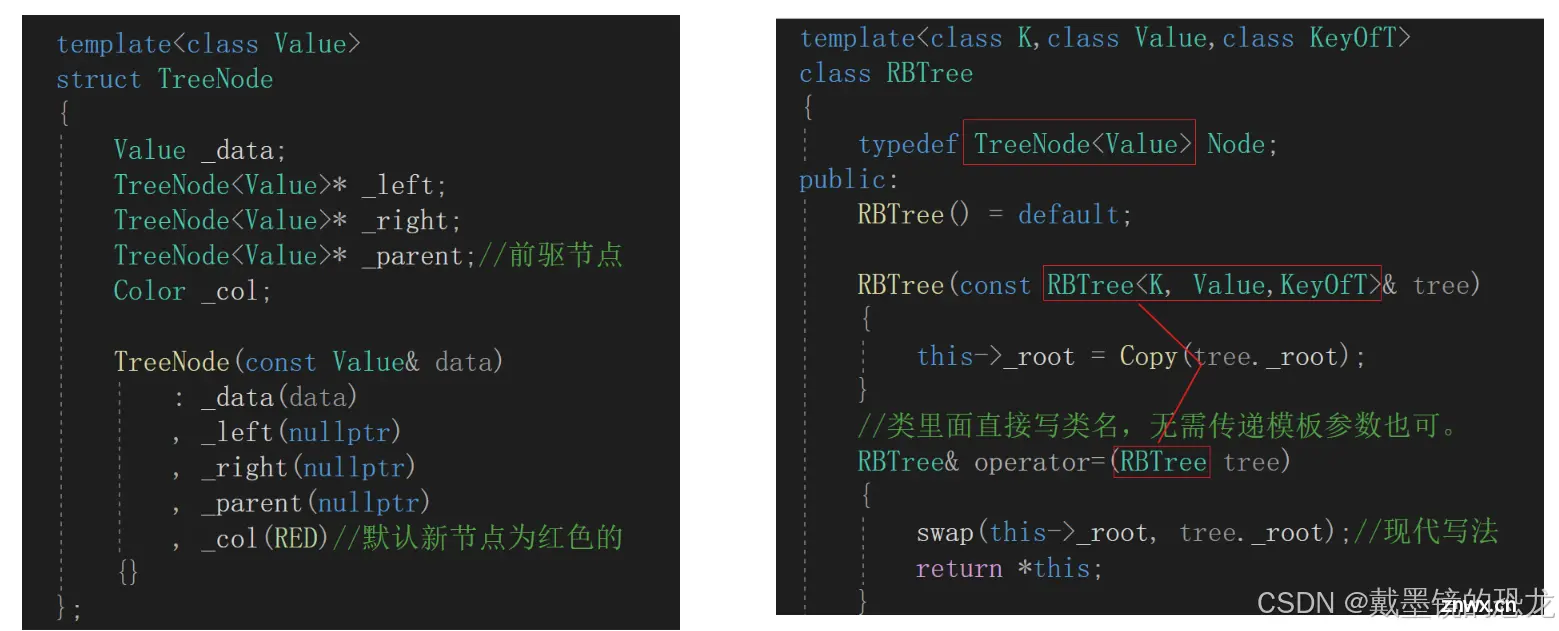
除了上面呈现出来的模板参数以外,还可以传递自定义的比较规则模板Compare。
下面是map与set的基本框架
原来红黑树中涉及数据比较大小的地方,都得回调传递过来的KeyOfT获取Key后再比较
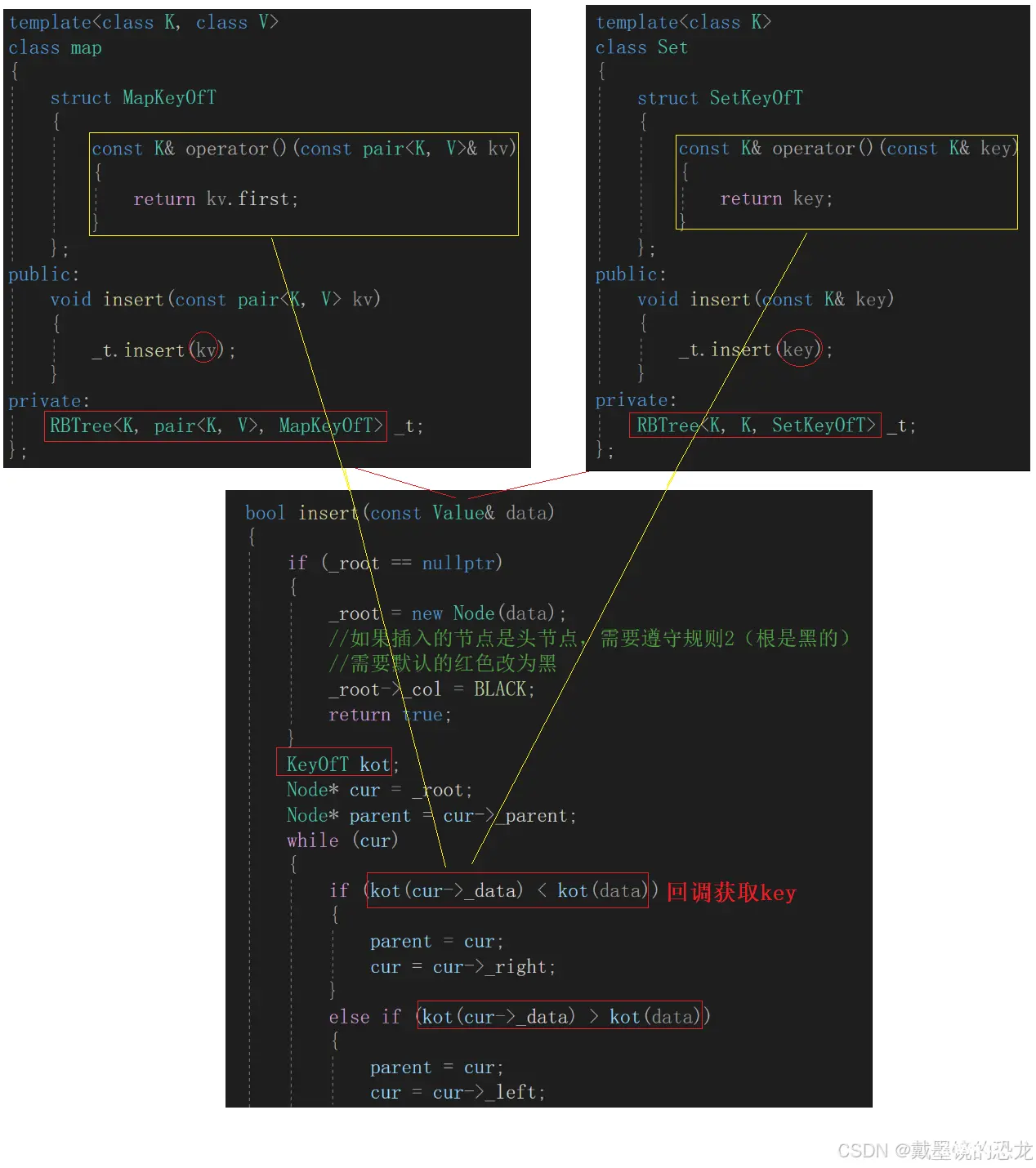
3. 红黑树的迭代器
3.1 普通迭代器
红黑树的迭代器无非也就是包含一个节点的指针,然后重载指针的各种操作即可。
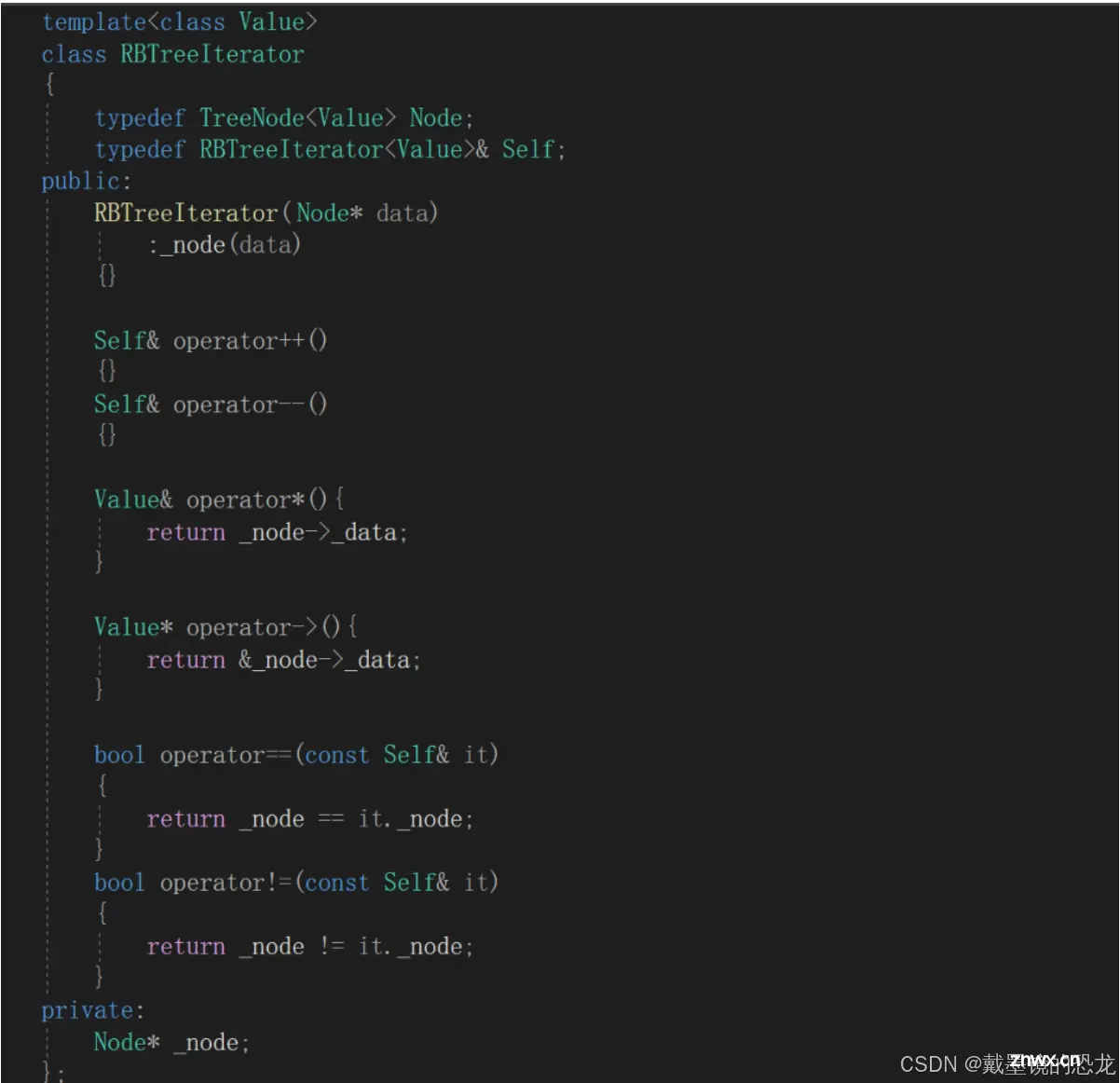
一般迭代器的实现都是按照中序遍历,遍历完是有序的。所以红黑树迭代器的begin(),应该是树最左侧的节点;对于迭代器的end(),我们就按照NULL来处理。
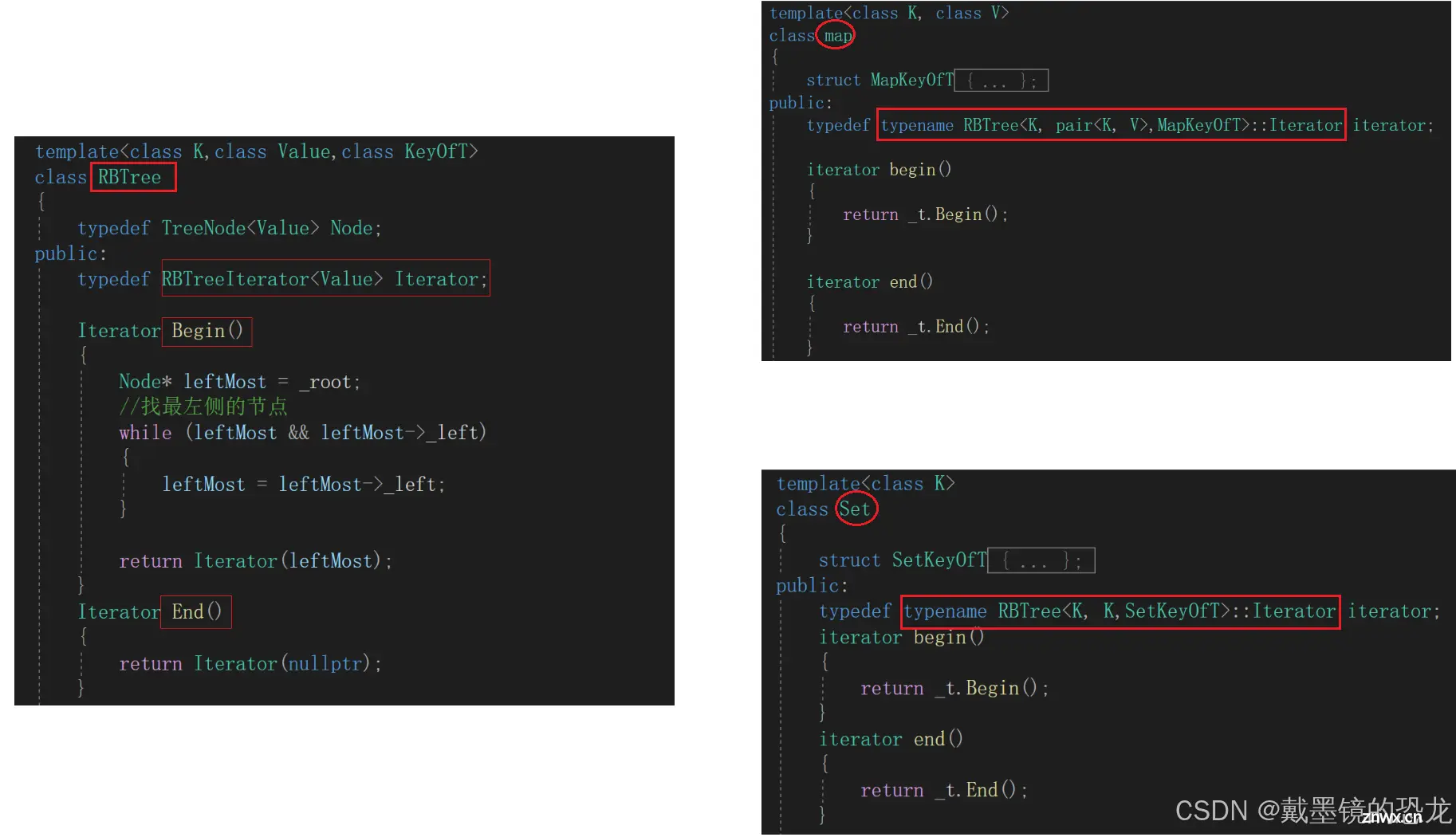
那红黑树迭代器的++与- -操作是如何实现的呢?
对于++操作:
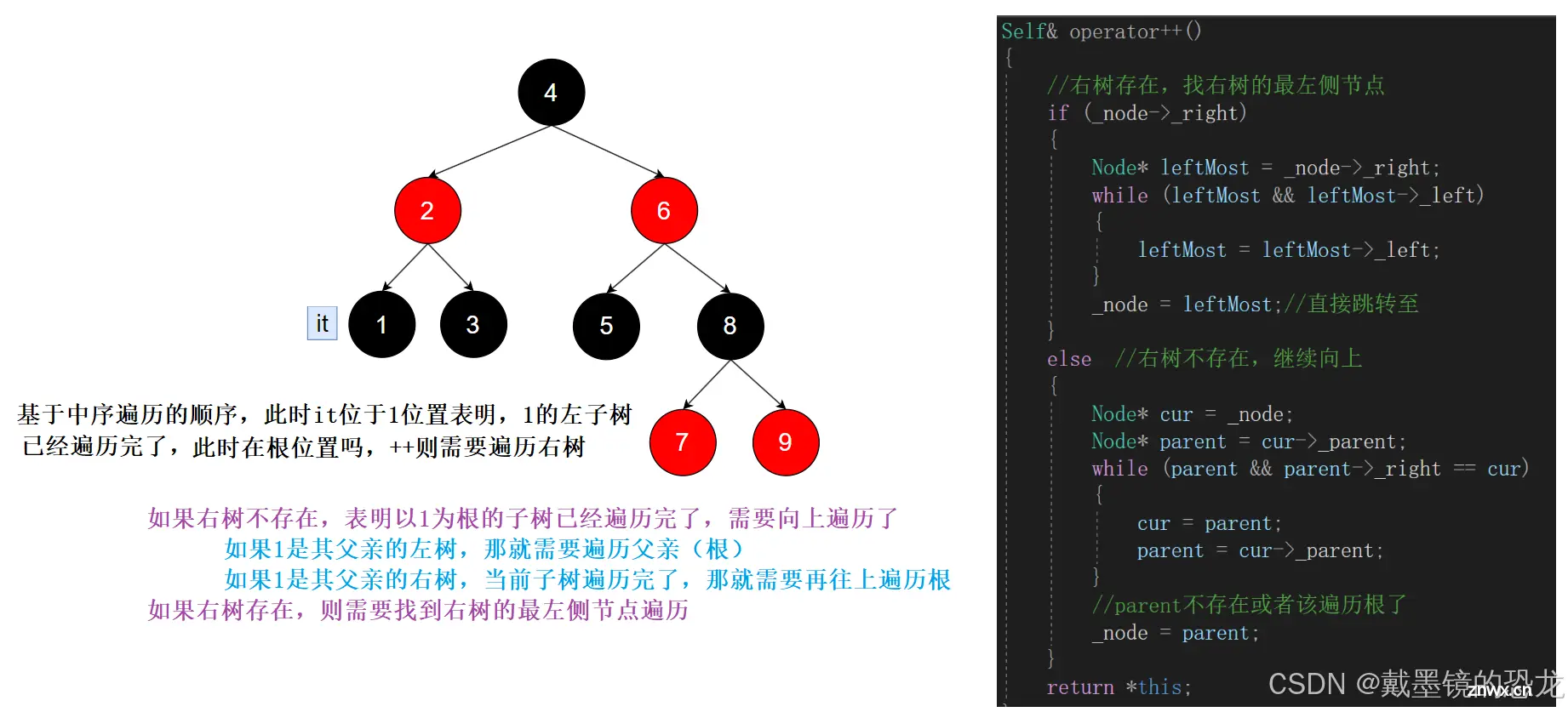
对于- -操作:为了方便_node == nullptr时找树最右侧的节点,我们再给迭代器加一个指针root记录树的根。

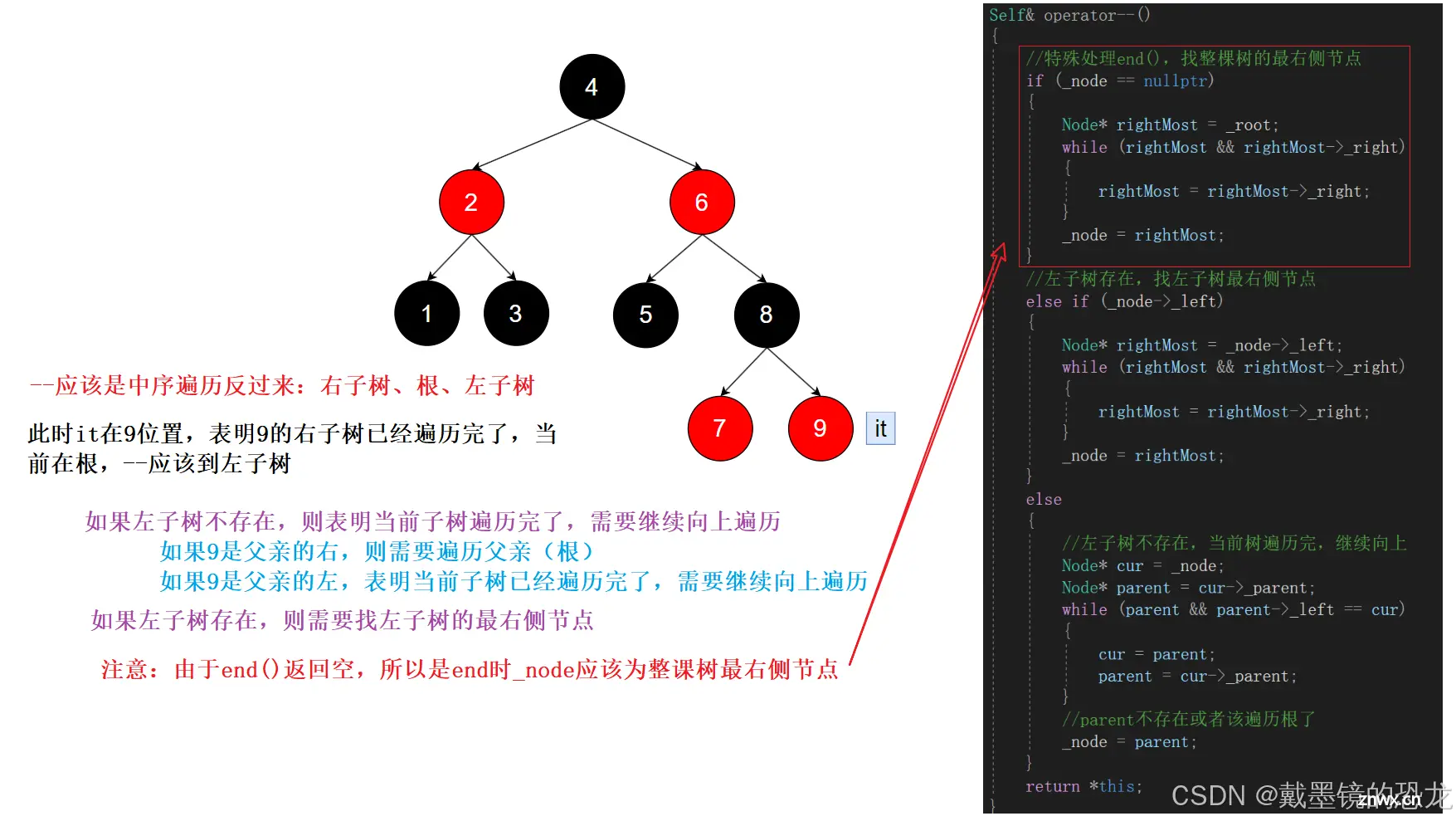
<code>template<class Value>
class RBTreeIterator
{ -- -->
typedef TreeNode<Value> Node;
typedef RBTreeIterator<Value> Self;
private:
Node* _node;
Node* _root;
public:
RBTreeIterator(Node* data,Node* root)
:_node(data)
,_root(root)
{ }
Self& operator++()
{
//右树存在,找右树的最左侧节点
if (_node->_right)
{
Node* leftMost = _node->_right;
while (leftMost && leftMost->_left)
{
leftMost = leftMost->_left;
}
_node = leftMost;//直接跳转至
}
else //右树不存在,继续向上
{
Node* cur = _node;
Node* parent = cur->_parent;
while (parent && parent->_right == cur)
{
cur = parent;
parent = cur->_parent;
}
//parent不存在或者该遍历根了
_node = parent;
}
return *this;
}
Self& operator--()
{
//特殊处理end(),找整棵树的最右侧节点
if (_node == nullptr)
{
Node* rightMost = _root;
while (rightMost && rightMost->_right)
{
rightMost = rightMost->_right;
}
_node = rightMost;
}
//左子树存在,找左子树最右侧节点
else if (_node->_left)
{
Node* rightMost = _node->_left;
while (rightMost && rightMost->_right)
{
rightMost = rightMost->_right;
}
_node = rightMost;
}
else
{
//左子树不存在,当前树遍历完,继续向上
Node* cur = _node;
Node* parent = cur->_parent;
while (parent && parent->_left == cur)
{
cur = parent;
parent = cur->_parent;
}
//parent不存在或者该遍历根了
_node = parent;
}
return *this;
}
Value& operator*(){
return _node->_data;
}
Value* operator->(){
return &_node->_data;
}
bool operator==(const Self& it)
{
return _node == it._node;
}
bool operator!=(const Self& it)
{
return _node != it._node;
}
};
3.2 const迭代器
对于const迭代器而言,无非就是数据不能被修改,那也就是针对迭代器的operator* 与operator->了。
那就先改造底层的迭代器
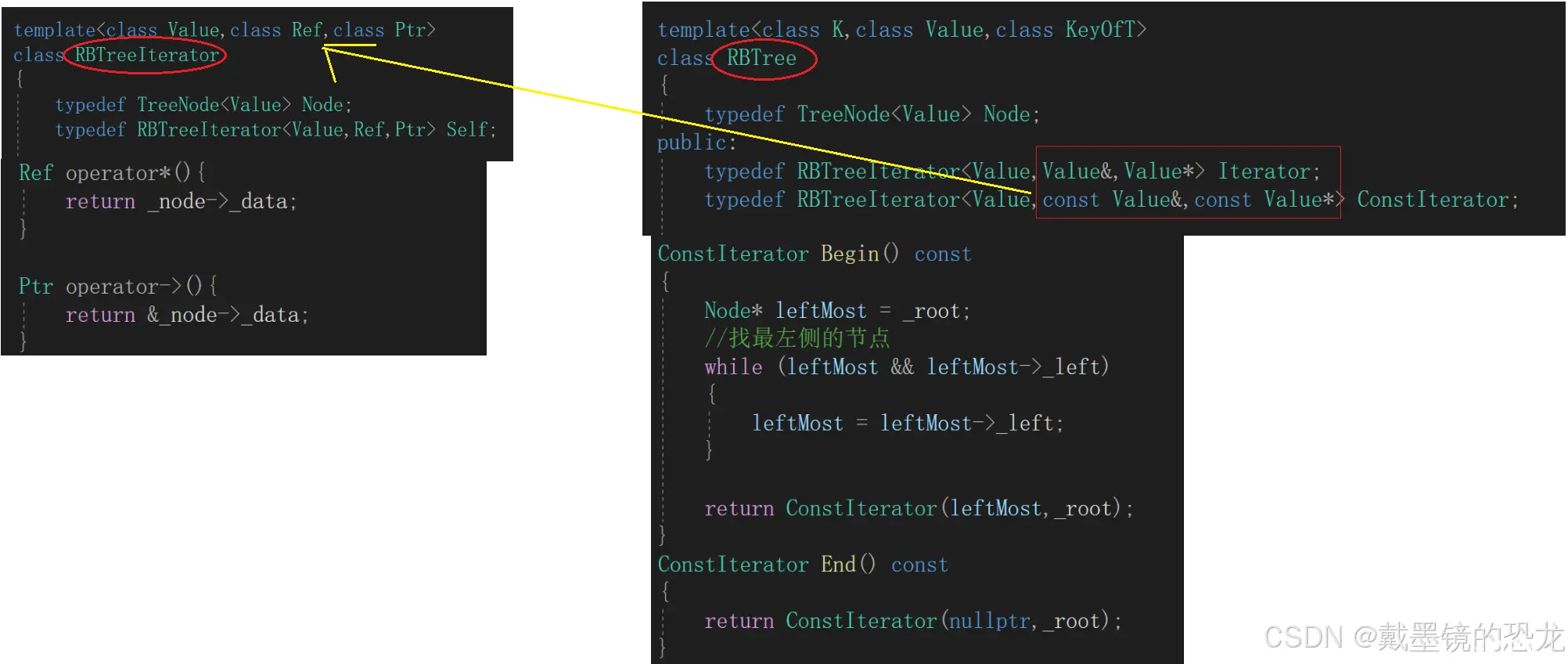
然后map与set在上层封一下就行了

通过上面的我们可以看到,使用const迭代器以后确实都不能修改了;但是普通迭代器存在一个问题:

所以上层在传递给下层时,我们可以将k设置为const

到这里我们的迭代器就完美了。
3.3 map的operator[ ]
我们都知道map重载的[ ]既可以充当插入,也可以充当修改。那么在底层它用的就是insert。(点击可看map的使用)
那我们就需要改变一下insert的返回值了。


到这里我们map与set的封装就结束了。
4. 完整代码
4.1 RBTree
<code>#pragma once
namespace my
{ -- -->
//颜色
enum Color
{
RED = 0,
BLACK
};
template<class Value>
struct TreeNode
{
Value _data;
TreeNode<Value>* _left;
TreeNode<Value>* _right;
TreeNode<Value>* _parent;//前驱节点
Color _col;
TreeNode(const Value& data)
: _data(data)
, _left(nullptr)
, _right(nullptr)
, _parent(nullptr)
, _col(RED)//默认新节点为红色的
{ }
};
template<class Value,class Ref,class Ptr>
class RBTreeIterator
{
typedef TreeNode<Value> Node;
typedef RBTreeIterator<Value,Ref,Ptr> Self;
private:
Node* _node;
Node* _root;
public:
RBTreeIterator(Node* data,Node* root)
:_node(data)
,_root(root)
{ }
Self& operator++()
{
//右树存在,找右树的最左侧节点
if (_node->_right)
{
Node* leftMost = _node->_right;
while (leftMost && leftMost->_left)
{
leftMost = leftMost->_left;
}
_node = leftMost;//直接跳转至
}
else //右树不存在,继续向上
{
Node* cur = _node;
Node* parent = cur->_parent;
while (parent && parent->_right == cur)
{
cur = parent;
parent = cur->_parent;
}
//parent不存在或者该遍历根了
_node = parent;
}
return *this;
}
Self& operator--()
{
//特殊处理end(),找整棵树的最右侧节点
if (_node == nullptr)
{
Node* rightMost = _root;
while (rightMost && rightMost->_right)
{
rightMost = rightMost->_right;
}
_node = rightMost;
}
//左子树存在,找左子树最右侧节点
else if (_node->_left)
{
Node* rightMost = _node->_left;
while (rightMost && rightMost->_right)
{
rightMost = rightMost->_right;
}
_node = rightMost;
}
else
{
//左子树不存在,当前树遍历完,继续向上
Node* cur = _node;
Node* parent = cur->_parent;
while (parent && parent->_left == cur)
{
cur = parent;
parent = cur->_parent;
}
//parent不存在或者该遍历根了
_node = parent;
}
return *this;
}
Ref operator*(){
return _node->_data;
}
Ptr operator->(){
return &_node->_data;
}
bool operator==(const Self& it)
{
return _node == it._node;
}
bool operator!=(const Self& it)
{
return _node != it._node;
}
};
template<class K,class Value,class KeyOfT>
class RBTree
{
typedef TreeNode<Value> Node;
public:
typedef RBTreeIterator<Value,Value&,Value*> Iterator;
typedef RBTreeIterator<Value,const Value&,const Value*> ConstIterator;
Iterator Begin()
{
Node* leftMost = _root;
//找最左侧的节点
while (leftMost && leftMost->_left)
{
leftMost = leftMost->_left;
}
return Iterator(leftMost,_root);
}
Iterator End()
{
return Iterator(nullptr,_root);
}
ConstIterator Begin() const
{
Node* leftMost = _root;
//找最左侧的节点
while (leftMost && leftMost->_left)
{
leftMost = leftMost->_left;
}
return ConstIterator(leftMost,_root);
}
ConstIterator End() const
{
return ConstIterator(nullptr,_root);
}
RBTree() = default;
RBTree(const RBTree<K, Value,KeyOfT>& tree)
{
this->_root = Copy(tree._root);
}
//类里面直接写类名,无需传递模板参数也可。
RBTree& operator=(RBTree tree)
{
swap(this->_root, tree._root);//现代写法
return *this;
}
~RBTree()
{
Destroy(_root);
}
pair<Iterator,bool> insert(const Value& data)
{
if (_root == nullptr)
{
_root = new Node(data);
//如果插入的节点是头节点,需要遵守规则2(根是黑的)
//需要默认的红色改为黑
_root->_col = BLACK;
return make_pair(Iterator(_root,_root),true);
}
KeyOfT kot;
Node* cur = _root;
Node* parent = cur->_parent;
while (cur)
{
if (kot(cur->_data) < kot(data))
{
parent = cur;
cur = cur->_right;
}
else if (kot(cur->_data) > kot(data))
{
parent = cur;
cur = cur->_left;
}
else
return make_pair(Iterator(cur, _root), false);
}
//孩子连父亲
cur = new Node(data);
Node* newnode = cur;
cur->_parent = parent;
//父亲连孩子
if (kot(parent->_data) < kot(data))
parent->_right = cur;
else
parent->_left = cur;
//检查是否违反红黑树的规则
//如果父亲存在且为红,则违反规则
while (parent && parent->_col == RED)
{
Node* grandfather = parent->_parent;
if (grandfather->_left == parent)
{
//根据爷爷节点找叔叔
Node* uncle = grandfather->_right;
//如果叔叔存在且为红,仅需要变色
if (uncle && uncle->_col == RED)
{
parent->_col = BLACK;
uncle->_col = BLACK;
grandfather->_col = RED;
//然后继续向上调整
cur = grandfather;
parent = cur->_parent;
}
//如果叔叔不存在 或者存在且为黑,需要旋转+变色
else
{
//判断单旋(直树)还是双旋(弯树)
//单旋
if (parent->_left == cur)
{
// g
// p u
//c
RotateR(grandfather);
parent->_col = BLACK;
grandfather->_col = RED;
}
//双旋
else
{
// g
// p u
// c
RotateL(parent);
RotateR(grandfather);
cur->_col = BLACK;
grandfather->_col = RED;
}
break;//旋转后已经符合规则,无需再调整了
}
}
//grandfather->_right == parent
else
{
Node* uncle = grandfather->_left;
//如果叔叔存在且为红,仅需要变色
if (uncle && uncle->_col == RED)
{
parent->_col = BLACK;
uncle->_col = BLACK;
grandfather->_col = RED;
//继续调整
cur = grandfather;
parent = cur->_parent;
}
//如果叔叔不存在 或者存在且为黑,需要旋转+变色
else
{
// g
// u p
// c
if (parent->_right == cur)
{
RotateL(grandfather);
parent->_col = BLACK;
grandfather->_col = RED;
}
// g
// u p
// c
else
{
RotateR(parent);
RotateL(grandfather);
cur->_col = BLACK;
grandfather->_col = RED;
}
break;
}
}
}
//父亲不存在,或者父亲为黑时,无需判断,直接将根变黑
_root->_col = BLACK;
return make_pair(Iterator(newnode, _root), true);
}
Iterator* find(const K& key)
{
Node* cur = _root;
KeyOfT kot;
while (cur)
{
if ( kot(cur->_data)< key)
cur = cur->_right;
else if (kot(cur->_data) > key)
cur = cur->_left;
else
return Iterator(cur,_root);
}
return End();
}
void InOrder()
{
_InOrder(_root);
cout << endl;
}
bool IsRBTree()
{
Node* root = _root;
if (root == nullptr)//空树也是
return true;
if (root->_col == RED)
{
cout << "根节点为红色,违反规则" << endl;
return false;
}
//先统计最左侧路径上有多少黑节点作为标准
Node* cur = root;
int blackNum = 0;
while (cur)
{
if (cur->_col == BLACK)
blackNum++;
cur = cur->_left;
}
//k用来记录路径中黑节点的个数
int k = 0;
//在依据标准黑节点的个数,比较其它路径
return _IsRBTree(root, blackNum, k);
}
int Size()
{
return _Size(_root);
}
int Height()
{
return _Height(_root);
}
private:
int _Height(Node* root)
{
if (root == nullptr)
return 0;
int leftH = _Height(root->_left);
int rightH = _Height(root->_right);
return leftH > rightH ? leftH + 1 : rightH + 1;
}
int _Size(Node* root)
{
if (root == nullptr)
return 0;
return 1 + _Size(root->_left) + _Size(root->_right);
}
bool _IsRBTree(Node* root, int blackNum, int k)
{
//一条路径走完,比较黑节点的个数
if (root == nullptr)
{
if (blackNum != k)
{
cout << "路径黑节点个数不相等,违反规则" << endl;
return false;
}
return true;
}
Node* parent = root->_parent;
if (parent && root->_col == RED && parent->_col == RED)
{
cout << "存在连续的红节点,违反规则" << endl;
return false;
}
//统计黑节点
if (root->_col == BLACK)
k++;
//统计完根,在依次统计左右子树
return _IsRBTree(root->_left, blackNum, k)
&& _IsRBTree(root->_right, blackNum, k);
}
void RotateR(Node* parent)
{
Node* SubL = parent->_left;
Node* SubLR = SubL->_right;
//降级连兵
parent->_left = SubLR;
if (SubLR)
SubLR->_parent = parent;
Node* parentParent = parent->_parent;
//升级连将
SubL->_right = parent;
parent->_parent = SubL;
//将连将
SubL->_parent = parentParent;
if (parentParent == nullptr)
{
_root = SubL;
}
else
{
if (parentParent->_left == parent)
parentParent->_left = SubL;
else
parentParent->_right = SubL;
}
}
void RotateL(Node* parent)
{
Node* SubR = parent->_right;
Node* SubRL = SubR->_left;
//降级连兵
parent->_right = SubRL;
if (SubRL)
SubRL->_parent = parent;
Node* parentParent = parent->_parent;
//升级连将
SubR->_left = parent;
parent->_parent = SubR;
//将连将
SubR->_parent = parentParent;
if (parentParent == nullptr)
_root = SubR;
else
{
if (parentParent->_left == parent)
parentParent->_left = SubR;
else
parentParent->_right = SubR;
}
}
void Destroy(Node* root)
{
if (root == nullptr)
return;
Destroy(root->_left);
Destroy(root->_right);
delete root;
}
Node* Copy(Node* root)
{
if (root == nullptr)
return nullptr;
_root->_left = Copy(root->_left);
_root->_right = Copy(root->_right);
return _root;
}
void _InOrder(Node* root)
{
if (root == nullptr)
return;
_InOrder(root->_left);
cout << root->_kv.first << " ";
_InOrder(root->_right);
}
Node* _root;
};
}
4.2 MyMap
#pragma once
#include"RBTree.h"
namespace my
{
template<class K, class V>
class map
{
struct MapKeyOfT
{
const K& operator()(const pair<K, V>& kv)
{
return kv.first;
}
};
public:
typedef typename RBTree<K, pair<const K, V>,MapKeyOfT>::Iterator iterator;
typedef typename RBTree<K, pair<const K, V>,MapKeyOfT>::ConstIterator const_iterator;
const_iterator begin()const
{
return _t.Begin();
}
const_iterator end() const
{
return _t.End();
}
iterator begin()
{
return _t.Begin();
}
iterator end()
{
return _t.End();
}
pair<iterator, bool> insert(const pair<K, V> kv)
{
return _t.insert(kv);
}
bool find(const K& key)
{
return _t.find(key);
}
V& operator[](const K& key)
{
pair<iterator, bool> ret = insert(make_pair(key,V()));
//如果key存在,则返回其对应的value
//如果key不存在,则插入它,其value为类型的默认值
return ret.first->second;
}
private:
RBTree<K, pair<const K, V>, MapKeyOfT> _t;
};
//void MapPrint(const map<string, string>& m)
//{
//map<string, string>::const_iterator it = m.end();
//while (it != m.begin())
//{
//it->first += "x";
//it->second += "y";
//--it;
//cout << it->first << " " << it->second << endl;
//}
//}
void testmap()
{
map<string, string> m;
m.insert({ "right","右"});
m.insert({ "up","上"});
m.insert({ "down","下"});
m.insert({ "left","左"});
m["left"] = "修改左";
m["offer"] = "新增";
//cout << m.find(3) << endl;
//for (auto& e : m)
//{
//cout << e.first << " " << e.second << endl;
//}
//MapPrint(m);
map<string,string>::iterator it = m.end();
while (it != m.begin())
{
//it->second += "y";
//it->first += "x";
--it;
cout << it->first << " " << it->second << endl;
}
cout << endl;
}
}
4.3 MySet
#pragma once
#include"RBTree.h"
namespace my
{
template<class K>
class set
{
struct SetKeyOfT
{
const K& operator()(const K& key)
{
return key;
}
};
public:
typedef typename RBTree<K, const K,SetKeyOfT>::Iterator iterator;
typedef typename RBTree<K, const K,SetKeyOfT>::ConstIterator const_iterator;
const_iterator begin() const
{
return _t.Begin();
}
const_iterator end() const
{
return _t.End();
}
iterator begin()
{
return _t.Begin();
}
iterator end()
{
return _t.End();
}
pair<iterator, bool> insert(const K& key)
{
return _t.insert(key);
}
bool find(const K& key)
{
return _t.find(key);
}
private:
RBTree<K, const K, SetKeyOfT> _t;
};
//void SetPrint(const set<int>& s)
//{
//set<int>::const_iterator it = s.end();
//while (it != s.begin())
//{
////*it = 20;
//--it;
//cout << *it << " ";
//}
//cout << endl;
//}
void testset()
{
set<int> s;
pair<set<int>::iterator,bool> ret = s.insert(5);
cout << *(ret.first) << endl;//查看insert的返回值
s.insert(2);
s.insert(8);
s.insert(15);
s.insert(2);
s.insert(9);
set<int>::iterator it = s.end();
while (it != s.begin())
{
//*it = 10;
--it;
cout << *it <<" ";
}
cout << endl;
//SetPrint(s);
}
}
上一篇: SpringBootWeb 篇-深入了解 Mybatis 概念、数据库连接池、环境配置和 Lombok 工具包
下一篇: C# 创建简单的WebService发布本地和调用方法及环境配置(VS2017)
本文标签
声明
本文内容仅代表作者观点,或转载于其他网站,本站不以此文作为商业用途
如有涉及侵权,请联系本站进行删除
转载本站原创文章,请注明来源及作者。